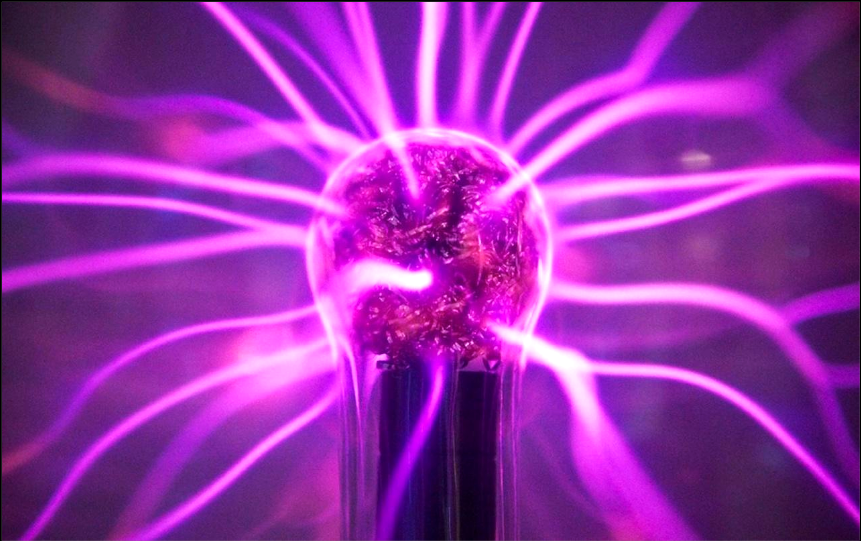
Introduction
Energy is a fundamental concept in physics, representing the capacity to do work or bring about a change in the physical state or motion of an object. It plays a pivotal role in understanding how the world functions and is integral to various scientific disciplines. In this context, we'll explore the concept of energy and its measurement using the International System of Units (SI).
Defining Energy: Energy, in its essence, is the ability to perform work. NASA, the National Aeronautics and Space Administration, succinctly defines it as the "ability to do work." This definition underscores energy's role in enabling various processes and transformations in the universe.
SI Unit for Energy - The Joule: In the International System of Units (SI), which is the globally accepted system of measurement, the standard unit for quantifying energy is the joule (J). One joule is precisely defined as the amount of energy transferred when a force of one newton (N) acts through a distance of one meter (m) in the direction of the applied force. In equation form, this relationship is expressed as:
1 joule (J) = 1 newton (N) ⋅ 1 meter (m)
The joule is an adaptable unit capable of measuring energy in various forms, encompassing mechanical, thermal, electrical, and other manifestations. It serves as the universal unit for quantifying energy across a wide spectrum of scientific fields, providing a common language for discussing and understanding energy-related phenomena.
Unit for measuring energy consumption
The commonly used unit for measuring energy consumption, especially in the context of electricity and power, is the kilowatt-hour (kWh). A kilowatt-hour is a measure of energy equal to the consumption of one kilowatt (1,000 watts) of power for one hour. It's widely used for billing electricity usage in households and businesses because it provides a convenient measure of total energy consumed over a specific period.
To simplify, if you have a 100-watt light bulb turned on for 10 hours, it will consume 1 kilowatt-hour of electricity. This is often referred to as "1 unit" in many billing systems. If electricity costs 5.00 per unit, it means that consumers pay 5.00 for every kilowatt-hour (kWh) of electrical energy consumed.
Forms of Energy
There are various forms of energy but energy is either potential energy or kinetic energy.
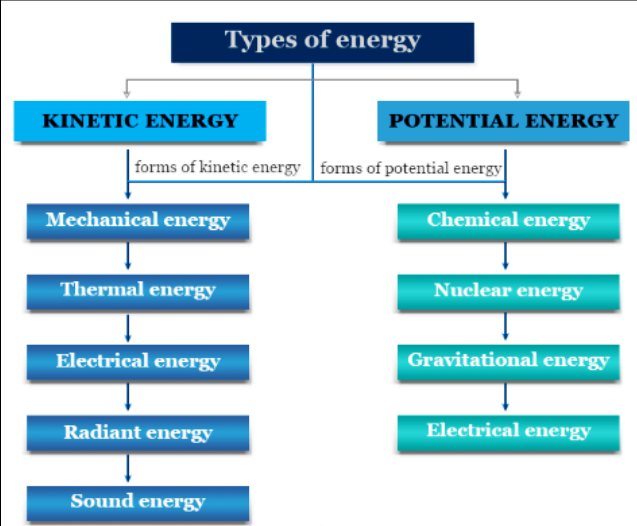
Potential Energy
Potential energy is associated with the position or condition of an object. It is a stored energy. There are several forms of potential energy, including:
- Gravitational Potential Energy: Gravitational potential energy is a concept in physics that refers to the energy associated with the position or height of an object in a gravitational field.
- When an object is allowed to fall from higher level to a lower level it gains speed due to gravitational pull, i.e. it gains kinetic energy.
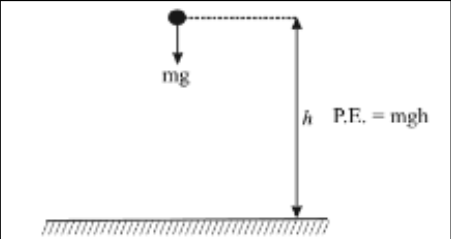
- Therefore, in possessing height, a body has the ability to convert its height into kinetic energy, i.e. it possesses potential energy.
- The magnitude of its gravitational potential energy is equivalent to the amount of work done by the weight of the body in causing the descent.
- If a mass m is at a height h above a lower level, the P.E. possessed by the mass is mgh.
- Since h is the height of an object above a specified level, an object below the specified level has negative potential energy.
- Elastic Potential Energy: The energy stored in objects like springs when they are stretched or compressed.
- Chemical Energy: This is the energy stored in the bonds between atoms and molecules. It is released or absorbed during chemical reactions. Common examples include the energy stored in fuels like gasoline or the chemical energy in batteries.
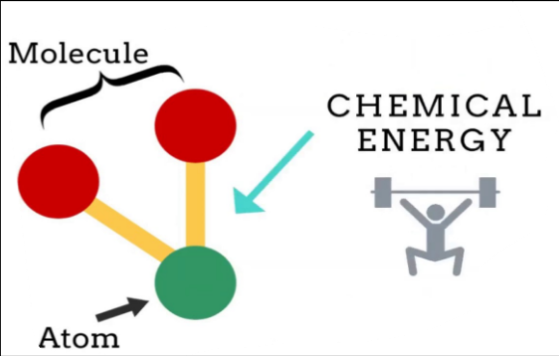
- Nuclear Energy: Nuclear energy is stored in the nucleus of atoms. It is released during nuclear reactions, such as nuclear fission (splitting of atomic nuclei) or nuclear fusion (combining of atomic nuclei). Nuclear power plants use nuclear energy to generate electricity.
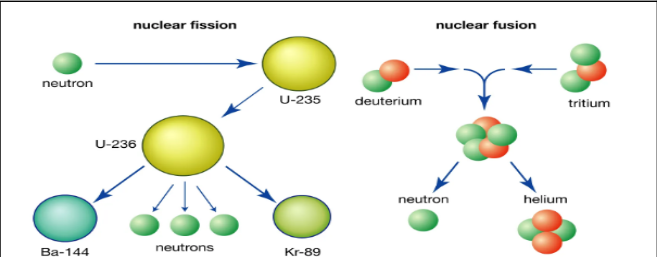
- Magnetic Energy: Magnetic energy is associated with magnetic fields and the potential for work to be done by moving magnetic objects. It's used in various technologies, including generators and magnetic storage devices.
Kinetic Energy
This is the energy of motion. Any object that is in motion possesses kinetic energy.
Examples:
- A stone thrown with some velocity, breaks the window pane.
- A moving vehicle, when accidently colliding with another vehicle at rest or motion, leads to destruction.
- Thermal (Heat) Energy: Thermal energy is associated with the motion of particles within a substance. It is related to temperature and can be transferred between objects as heat. Heat energy is vital for processes like cooking, heating, and thermodynamic engines.
- Radiant Energy (Electromagnetic Energy): This energy is in the form of electromagnetic waves, including visible light, radio waves, microwaves, and X-rays. It carries energy and can be harnessed for various purposes, such as solar panels converting sunlight into electrical energy.
- Sound Energy: Sound energy is the energy associated with the vibrations of particles in a medium (e.g., air, water). It travels in the form of waves and can be converted into electrical energy in devices like microphones.
- Electrical Energy: This energy is associated with the flow of electric charge, typically through wires or circuits. It is the form of energy used to power electrical devices and systems.
- Motion energy or mechanical energy is the movement of objects and substances from one place to another. According to Newton’s Laws of Motion, objects and substances move when an unbalanced force is applied. Wind is an example of motion energy.
Mass-Energy equivalence
Einstein's mass-energy equivalence relation, represented by the equation E=mc², is a fundamental concept in physics. It states that energy (E) and mass (m) are interchangeable and equivalent. In other words, mass can be converted into energy, and vice versa, under certain conditions.
This idea implies that even a small amount of mass contains a significant amount of energy. When mass is transformed into energy, it can release a substantial amount of power. This concept has profound implications in nuclear physics, where the conversion of mass into energy is responsible for the energy released in nuclear reactions, such as those in the sun or in nuclear power plants.
In essence, E=mc² is a foundational principle that has shaped our understanding of the relationship between matter and energy in the universe. It is not only a concept of scientific importance but also has practical applications, particularly in the field of nuclear energy and particle physics.
Key points and implications of the mass-energy equivalence relation:
- Energy from Mass: This equation shows that mass can be converted into energy and vice versa. In other words, mass and energy are interchangeable. When mass is converted into energy, it can release a tremendous amount of energy.
- Nuclear Reactions: The mass-energy equivalence relation is crucial for understanding nuclear reactions, such as those that occur in the sun (nuclear fusion) or in nuclear power plants (nuclear fission). In these reactions, a tiny amount of mass is converted into a large amount of energy.
- Atomic Bombs: The most famous application of this equation is in the development of atomic bombs. The release of energy in nuclear explosions is a result of the conversion of a small amount of mass into an enormous amount of energy.
- Understanding the Universe: This equation is also important for cosmology and understanding the behavior of the universe. It plays a role in the theory of Big Bang cosmology and the relationship between the energy content of the universe and its expansion.
- Everyday Technology: While the mass-energy equivalence relation is most famously associated with high-energy physics and cosmology, it also has practical applications in everyday technology, such as in medical imaging devices like PET (Positron Emission Tomography) scanners.
- Einstein's Theory of Special Relativity: This equation is a direct consequence of Albert Einstein's theory of special relativity, which fundamentally changed our understanding of space and time. Special relativity also introduced the concept that the speed of light is a constant in all reference frames.
|
Renewable energy sources
|
